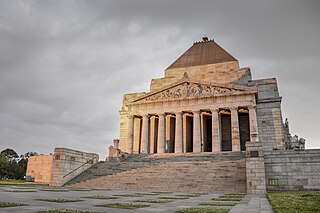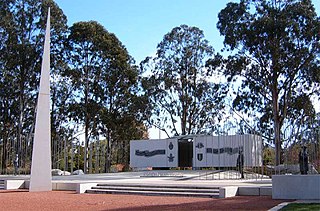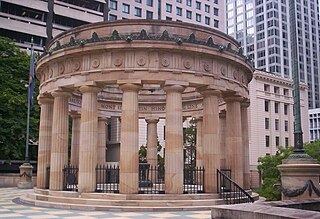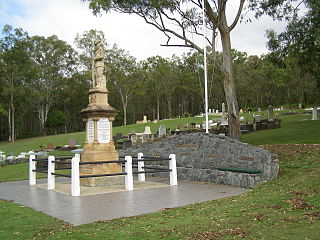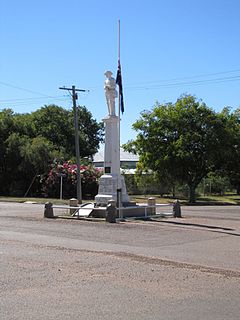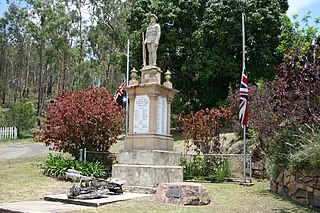This article includes a list of references, related reading or external links, but its sources remain unclear because it lacks inline citations .(January 2013) (Learn how and when to remove this template message) |

The Australian Army Memorial on Anzac Parade commemorates the service of Australian soldiers.

The Australian Army is Australia's military land force. Formed in 1901 through the amalgamation of the Australian colonial forces following federation, it is part of the Australian Defence Force (ADF) along with the Royal Australian Navy and the Royal Australian Air Force. While the Chief of the Defence Force (CDF) commands the ADF, the Army is commanded by the Chief of Army (CA). The CA is therefore subordinate to the CDF, but is also directly responsible to the Minister for Defence. Although Australian soldiers have been involved in a number of minor and major conflicts throughout Australia's history, only in Second World War has Australian territory come under direct attack.
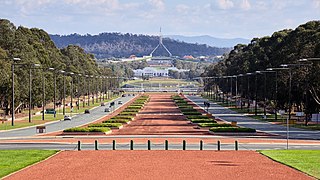
Anzac Parade, a significant road and thoroughfare in the Australian capital Canberra, is used for ceremonial occasions and is the site of many major military memorials.
Contents
Australian soldiers have fought as a national group in conflicts since the Second Boer War in South Africa. This memorial commemorates their continuing tradition of service, in war, conflict and peace operations.

The Second Boer War was fought between the British Empire and two Boer states, the South African Republic and the Orange Free State, over the Empire's influence in South Africa. It is also known variously as the Boer War, Anglo-Boer War, or South African War. Initial Boer attacks were successful, and although British reinforcements later reversed these, the war continued for years with Boer guerrilla warfare, until harsh British counter-measures brought the Boers to terms.

South Africa, officially the Republic of South Africa (RSA), is the southernmost country in Africa. It is bounded to the south by 2,798 kilometres (1,739 mi) of coastline of Southern Africa stretching along the South Atlantic and Indian Oceans; to the north by the neighbouring countries of Namibia, Botswana, and Zimbabwe; and to the east and northeast by Mozambique and Eswatini (Swaziland); and it surrounds the enclaved country of Lesotho. South Africa is the largest country in Southern Africa and the 25th-largest country in the world by land area and, with over 57 million people, is the world's 24th-most populous nation. It is the southernmost country on the mainland of the Old World or the Eastern Hemisphere. About 80 percent of South Africans are of Bantu ancestry, divided among a variety of ethnic groups speaking different African languages, nine of which have official status. The remaining population consists of Africa's largest communities of European, Asian (Indian), and multiracial (Coloured) ancestry.
The memorial was unveiled by the Governor-General of Australia, The Hon. Bill Hayden AC on 1 November 1989. Presented on behalf of the people of Australia: Prime Minister of Australia, Bob Hawke AC.

The Governor-General of the Commonwealth of Australia is the representative of the Australian monarch, currently Queen Elizabeth II. As the Queen is concurrently the monarch of 15 other Commonwealth realms, and resides in the United Kingdom, she, on the advice of her prime minister, appoints a governor-general to carry out constitutional duties within the Commonwealth of Australia. The governor-general has formal presidency over the Federal Executive Council and is commander-in-chief of the Australian Defence Force. The functions of the governor-general include appointing ministers, judges, and ambassadors; giving royal assent to legislation passed by parliament; issuing writs for election; and bestowing Australian honours.
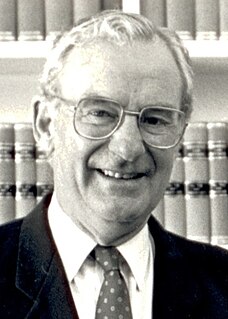
William George Hayden is a former Australian politician who served as the 21st Governor-General of Australia, in office from 1989 to 1996. He had earlier been leader of the Labor Party from 1977 to 1983, as well as serving as a cabinet minister in the Whitlam and Hawke Governments.

The Order of Australia is an order of chivalry established on 14 February 1975 by Elizabeth II, Queen of Australia, to recognise Australian citizens and other persons for achievement or meritorious service. Before the establishment of the order, Australian citizens received British honours.





